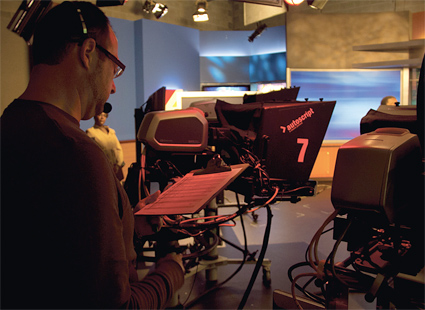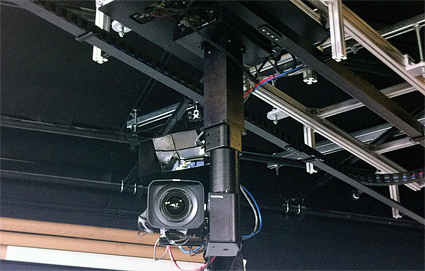I, Robotics
What we call “camera robotics” is actually a hybrid of both remote control by a human hand and true robotics that are pre-programmed and work autonomously. They started to move into professional studios in a big way in the 1980s and have been taking over the role of studio camera operators ever since.
However, it not just about replacing camera operators.

Dan Ragase, floor director/editor at WJXT-TV in Jacksonville, Fla., prepares for a news broadcast with Grass Valley Ignite HDC cameras. “Aside from the obvious efficiencies and reduction of labor costs, some modern camera-control systems allow for more dynamic, repeatable moves that can be used to improve a production or differentiate the brand from a competitor,” said Brad Rochon, OverDrive marketing product manager for Ross Video in Canada.
For a station planning its first camera robotics system, Rochon mentioned a couple areas that need special attention to ensure the best results.
“Camera blocking and camera movements are two areas that require more thought than first considered when moving to robotics,” he said. “Other functions that need careful consideration are camera shading, who will be operating the panel and also studio lighting responsibilities.”
THINKING IT THROUGH
Alex Holtz, senior director for marketing and market development for Grass Valley, said that the staff at some stations doesn’t think through all the consequences of camera robotics.
“When first [considering] the use of robotic cameras, some stations forget about the simple things such as, ‘How do I transition my robotic cameras from one set to another when moving them on fixed tripods with dolly wheels that affect the stored presets?’” Holtz said. “Some stations use tape to mark locations, while others use laser alignment and others use fixed pins where holes are drilled into the floor. Whatever the method, this is probably one of the most overlooked scenarios during the design and implementation process.”
Telemetrics started with fairly modest remote pan/tilt systems 25 years ago and now has a full line of remote camera-support equipment. Communications can be tricky with some elaborate camera movement products.
“First and foremost is the need for proper cabling and network configuration to allow for trouble-free remote control,” said Anthony Cuomo, vice president and general manager of Telemetrics. “A variety of product solutions, including floor-, wall- and ceiling-mounted tracks and frames, elevating pedestals, trolley systems and programmable pan/tilt units are available to meet even the most demanding studio environments.”
Which brings up the subject of how camera automation is controlled. Just about every permutation is possible, from having a human hand pan-and-tilt cameras remotely to pedestals and cameras that move on cue from production switcher selections.
In addition to Grass Valley, Telemetrics and Ross Video, several manufacturers build equipment for camera robotics, such as Shotoku, Fujinon and Canon. A large vendor in this product space is the Vitec Group, which owns such venerable camera-support brands as Vinten Radamec, OConnor, Manfrotto and Sachtler. As separate companies, Vinten and Radamec were well known for supplying camera automation systems at the highest level of broadcasting.
With just about every type of control capability supported by vendors, how do you know which is the right approach for your operation?

A Telemetrics overhead tracking system is used for moving a camera through a New York studio. “In preparation for the design and installation of camera robotics, the news director as well as the production and engineering staff should collaborate on what they want to accomplish,” Holtz said. “All live programming should be reviewed and discussed to determine best views on set utilization and expected transitions for shot blocking.”
Your budget is obviously important, and there could be labor concerns if there are union workers involved. Forgetting for a moment that camera automation will likely eliminate positions, a station’s union agreement may prevent camera operators from manipulating remote control panels.
INTEGRATED SOLUTIONS
If you are thinking that you will have to mix and match equipment in a studio project, Grass Valley, Sony, Panasonic and Canon (among others) supply integrated camera and pan/tilt systems that cover a wide range of applications from industrial to network broadcast.
“The Grass Valley HDC camera system [provides] precise operations through its Shot Director multi-camera controller,” Holtz said. “The Shot Director [lets] the operator store pre-sets that include not just the pan, tilt and zoom settings, but also the CCU functions to quickly recall shots in various lighting, skin tone and environmental conditions.”
Holtz pointed out that such integrated systems are economical.
“In many cases, depending on the model lens that is selected, you can purchase two or three Grass Valley camera systems for what it typically costs the station to purchase a single robotic pedestal,” he said.
However, there are also plenty of solutions that let you choose the individual gear most appropriate for your needs, or to use cameras and associated equipment that you already own.
“Ross Video’s OverDrive was designed to be vendor agnostic,” Rochon said. “OverDrive supports 12 different robotic camera vendors, which means that Ross customers have the choice to select the brand that fits their budgetary and production requirements.”
There are plenty of reasons why a broadcaster should consider camera robotics.
“The gains in cost savings, improved efficiency and increased creative flexibility are just some of the benefits that stations can expect when they implement camera robotics and control systems,” Cuomo said. “Overall, camera control systems can streamline production procedures and help to create new workflow strategies.”
No two broadcasters have same requirements or production and engineering staffs with the same preferences. Fortunately, there is a wide range of systems for any type of camera automation operation, and plenty of companies offering both products and integration assistance.
Get the TV Tech Newsletter
The professional video industry's #1 source for news, trends and product and tech information. Sign up below.
Bob Kovacs is the former Technology Editor for TV Tech and editor of Government Video. He is a long-time video engineer and writer, who now works as a video producer for a government agency. In 2020, Kovacs won several awards as the editor and co-producer of the short film "Rendezvous."

